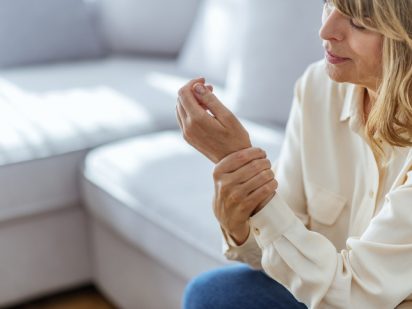Worldwide, one in three women and one in five men over the age of 50 will suffer an osteoporotic fracture.
In 2020, it was estimated that cases of osteoporosis, a condition that causes bones to become weak and brittle, would increase to 14 million.
According to the International Osteoporosis Foundation (IOF), osteoporosis causes bones to become more porous and fragile, greatly increasing the risk of painful and often disabling broken bones.
Bones develop and grow in the body until a person is in their early 20s, at which time they reach peak bone mass, when bones are at their strongest, densest, and least likely to fracture. “Throughout life, bone is constantly being renewed, with new bone replacing old bone – and this helps to keep our skeleton strong,” the IOF said on its website. “But for people with osteoporosis, more and more bone is lost and not replaced. This means that the bones gradually become brittle and more likely to break.”
Osteoporosis is considered a silent disease because there are generally no symptoms, explained Lisa Brandt, ACNP-BC, a member of Trinity Health’s Rheumatology department. “You may notice a loss of height or suffer a fracture.”
Appropriate screening is important because a fracture can be life changing, Brandt said, adding that pain, potential surgery, risks associated with surgery, and recovery time are factors.
Screening is generally recommended at age 65 for women and age 70 for men, she said. This is done using a DEXA scan, which measures done density. The test is painless and similar to an x-ray, but it uses less radiation, Brandt added. “A DEXA scan result will show either normal bone mineral density, meaning no treatment is indicated; osteopenia; or osteoporosis.
“Osteopenia is a bone mineral density less than normal, but not to the extent of osteoporosis,” Brandt explained. A special calculation using patient risk factors for osteoporosis, called a FRAX score, will be used to determine the probability of fracture and if treatment is needed for those with osteopenia. “If the DEXA scan shows osteoporosis, treatment is strongly recommended.”
Management options for osteoporosis include calcium and vitamin D supplementation, as well as regular physical activity with weight-bearing exercises. “Medications are generally well-tolerated and can be prescribed as a pill, injection, or IV infusion,” Brandt said. “The goal of treatment is generally to help slow bone loss in order to decrease fracture risk. The best choice of medication will be discussed and decided on at your appointment.”
Common medications to treat osteoporosis include bisphosphonate medications, such as alendronate, which is generally given as a once-a-week pill; zoledronic acid infusion, given once a year by IV in the Rheumatology clinic; antireabsorptive medication, such as Prolia, an injection given in the clinic every six months; or teriparatide, which is an injection given at home daily.
There are some measures that can be taken to prevent osteoporosis. These measures include:
Calcium
Calcium makes bones hard and dense. If calcium levels are too low, the body takes it from the bones. Too much loss can lead to osteoporosis.
Starting at age 50, you need about 1,200 milligrams of calcium a day to stop bone loss. To stock up for adulthood, between the ages of 9 and 18, about 1,300 milligrams of calcium should be taken daily.
Good sources of calcium include:
- 1 cup plain low-fat yogurt (300 milligrams)
- ½ cup firm tofu with calcium (200 milligrams)
- 1 cup baked beans (140 milligrams)
- 3 oz. canned salmon with edible bones (180 milligrams)
Vitamin D
Without vitamin D, your body can’t absorb the calcium from foods, which forces your body to take calcium from your bones. This not only weakens bones, but it can prevent the body from building strong new bone. Normal levels of Vitamin D for adults are 20 ng/mL; having less than 12 ng/mL means you are vitamin D deficient.
The skin makes vitamin D from sunlight. Good sources of vitamin D also include:
- Fatty fish like salmon, tuna, or mackerel
- Fortified milk from cows, almonds, soy, and oats
- Eggs
- Pork
- Fortified cereal
- Supplements can also help
Exercise
The more you exercise, the more your body responds by adding more bone. Also, exercise builds muscles, which help improve balance and coordination, leading to less falls.
Weight-bearing activities, such as running, walking, dancing, or climbing stairs, can help strengthen bones in the legs and feet. Strength training, such as push-ups, free weights, rowing, and resistance bands, can help make bones grow heavier and denser.
Smoking
Smoking is a known risk factor for osteoporosis as nicotine and other chemicals in tobacco slow the production of bone-forming cells and hinder blood flow to the bones.
Sugar
Too much sugar can cause damage to bone health. Sugar can cause the body to flush out bone-strengthening calcium and magnesium through your urine; it prevents the intestines from taking in enough calcium; and it displaces important nutrients from your diet.
Alcohol
Heavy drinking – that is 15 drinks (12 oz. of beer, 5 oz. of wine, or 1.5 oz of vodka, whiskey, or other hard liquor) or more per week for men; eight drinks or more for women – can lead to more falls, as well as making bones easier to break by interfering with osteoblasts, cells that cause bone growth.
Trinity Health Rheumatology department, which also includes Erdal Diri, MD, is located in Health Center-Medical Arts, 400 Burdick Expy E, Minot. For more information or to make an appointment, call 701-857-7495. Depending on insurance, a patient may need a referral from their general healthcare provider.

